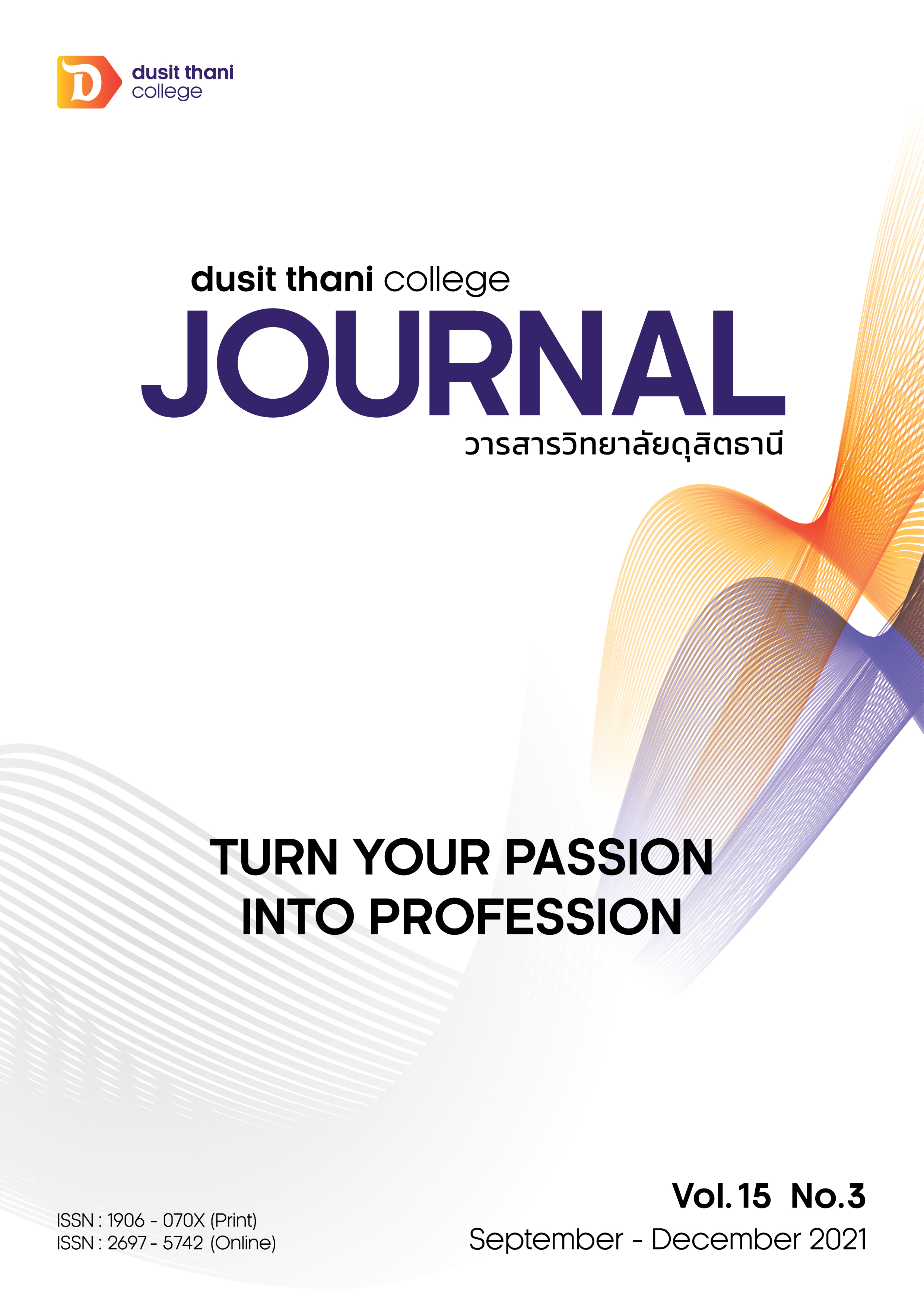TOURIST BEHAVIOR ON THE NEW NORMALITY IN MAHA SARAKHAM PROVINCE
Main Article Content
บทคัดย่อ
The purpose of this research was 1) to study the current tourism situation of Maha Sarakham Province. And 2) to study tourists’ behavior on the new normality in Maha Sarakham Province. The research period was from March 2020 to January 2021 with a sample of 400 people involved in tourism in Maha Sarakham Province. Stratified Random Sampling was used. The data were analyzed by using descriptive statistics. Most tourists have a travel purpose. 73.9% of travel/visits, frequent travel per month, 67.4%, traveling alone 18.0%, number of traveling companions, 27.6% having the type of vehicle that you use to travel Private car, 64.7 percent, travel time less than 1 day, travel expenses 1,000 baht or less than 42.9 percent. What media do tourists know about the tourist attractions in this province? Internet/website / social networks such as Facebook, Line, etc. 40.4% for travel behavior on the new normal of tourism in Maha Sarakham Province, concluded that most tourists have opinions of tourists on Maha Sarakham Province Guide Tourists plan to travel to natural sites in the future. The highest level ( x̄ = 4.98) followed by taking into account cleanliness. The highest level ( x̄ = 4.81) and the least comment level was the need to travel to the festival area. at a low level ( x̄ = 2.20)
Article Details
นโยบายการพิจารณากลั่นกรองบทความ
- บทความวิจัยและบทความวิชาการทุกเรื่องที่จะได้รับการตีพิมพ์ต้องผ่านการพิจารณากลั่นกรองโดยผู้ทรงคุณวุฒิ (Peer Review) ในสาขาที่เกี่ยวข้อง จำนวน 3 ท่าน/บทความ
- บทความ ข้อความ ภาพประกอบและตารางประกอบที่ลงตีพิมพ์ในวารสารเป็นความคิดเห็นส่วนตัวของผู้เขียน กองบรรณาธิการไม่จำเป็นต้องเห็นด้วยเสมอไป และไม่มีส่วนรับผิดชอบใด ๆ ถือเป็นความรับผิดชอบของผู้เขียนแต่เพียงผู้เดียว
- บทความที่จะได้รับการตีพิมพ์จะต้องไม่เคยตีพิมพ์ เผยแพร่ที่ใดมาก่อน และไม่อยู่ระหว่างการพิจารณาของวารสารฉบับอื่น หากตรวจสอบพบว่ามีการตีพิมพ์ซ้ำซ้อน ถือเป็นความรับผิดชอบของผู้เขียนแต่เพียงผู้เดียว
- บทความใดที่ผู้อ่านเห็นว่าได้มีการลอกเลียนหรือแอบอ้างโดยปราศจากการอ้างอิง หรือทำให้เข้าใจผิดว่าเป็นผลงานของผู้เขียน กรุณาแจ้งให้กองบรรณาธิการวารสารทราบจะเป็นพระคุณยิ่ง
เอกสารอ้างอิง
Abdul-Rahaman, A. R., & Hongxing, Y. (2020). China's new normal and the implications to domestic and global business. International Journal of Finance & Economics, 25 (2), 157-171.
Davis, E. (2020). Our ‘new normal’. Early Years Educator, 22 (1), 14-16.
Krajangchom, Sansanee (2020). The Adaptation Strategy of Tourism in Upper North of Thailand under the COVID-19 Pandemic: The Adaptation Strategy of Tourism in Upper North of Thailand under the COVID-19 Outbreak. University of the Thai Chamber of Commerce Journal Humanities and Social Sciences, 41 (1), 1-20.
Maha Sarakham Provincial Tourism and Sports Office (2020). Tourism Situations of Maha Sarakham Province. Maha Sarakham: Maha Sarakham Provincial Tourism and Sports Office.
Bhaskara, G. I. (2021). The COVID-19 pandemic and organizational learning for disaster planning and management: A perspective of tourism businesses from a destination prone to consecutive disasters. Journal of Hospitality and Tourism Management, 364-375.
Dab Petch, Siripen. (2020). Selecting attractions for first-time and repeat tourists. Journal of Business Administration Economics and Communication, 41-59.
Ministry of Higher Education, Science, Research and Innovation. (2020). New Normal, new way of life and adaptation in the situation of COVID-19. Bangkok, Ministry of Higher Education, Science, Research and Innovation
Ministry of Tourism and Sports (2020). New Normal For entrepreneurs traveling after the Covid-19 situation. Office of the Permanent Secretary, Ministry of Tourism and Sports.
Kaewchor, Patchareeya (2021). Factors Influencing Change in New Normal Tourism Behavior after the COVID-19 Epidemic. Faculty of Business Administration Ramkhamhaeng University, 77-89.
Kodaphat, Phuttapon (2019). A study of behavior and satisfaction of Thai tourists for Develop a tourist attraction following the movie footprint of Alexander, Ubon Ratchathani Province. Journal of Humanities and Social Sciences Ubon Ratchathani Rajabhat University, 158-171.
Sharma, G. D. (2021). Reviving tourism industry post-COVID-19: A resilience-based framework. Tourism Management Perspectives, 107-118.
Shaikh, A. (2020). Coronavirus Is Our Future. [cited 2020June 8]. Available from https://www.youtube.com/watch?v=Fqw-9yMV0s
Supasorn, Yuthasak (2021). Thai travel in the world after COVID. Bangkok: Tourism Authority of Thailand.
Tangtenglam, Susaraporn and Chidprasert, Chonchanok. (2020). The New Normal Confidence of Tourists ServiceDomestic Airlines. Dusit Thani College Journal, 15 (1), 37-47.
Tourism Authority of Thailand. (2020). Forecast the trend of the tourism situation. TAT Review, 1-12.
Wanichbancha, Kalaya. (1999). Statistics for decision making. Statistical analysis. 3. Type 3. Krung Thep: Chulalongkorn University Printing Center. 1999.Thawin Kuekulwong. Modern education administration, theory of research and practice. Bangkok:Wattana Panich.
Zhang, H. (2021). Forecasting tourism recovery amid COVID-19. Annals of Tourism Research, 103-149.


